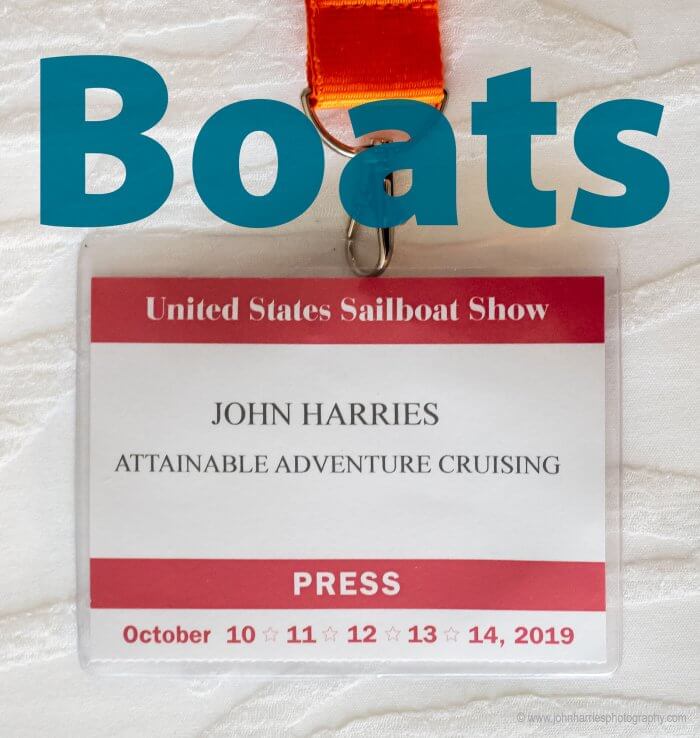
I just got back from the United States Sailboat Show in Annapolis, Maryland, with about a billion photographs to edit and my head spinning with all of the articles I want to write.
It will probably take most of the winter to crank all those out, so let’s start with a quick overview:
Three Offshore Cruising Boats

The boat that really called out to me as ocean voyaging ready for short-handed crews was the Outbound 46.

I spent most of my first morning at the show on the boat getting an indepth tour from Phil Lambert, her creator.
Much more on that in a separate article.

I also spent time on the Hallberg-Rassy 48 MkII, and will be writing more about that boat as well.
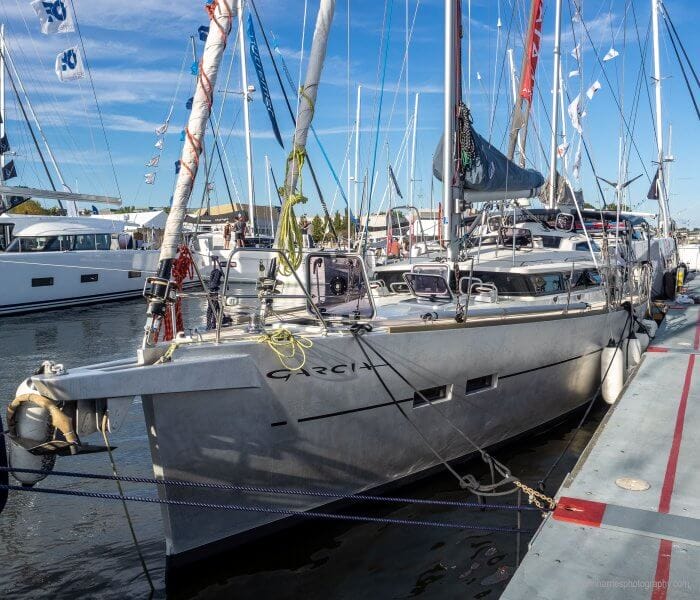
Pete and Tracey Goss had their new Garcia Exploration 45 at the show. I spent an hour or so aboard and will be writing about the boat and how it compares to the Boréal 47, its main competitor.
Limitations Of a Show
Of course, none of this compares to spending an extended time on a boat and going sailing but, none-the-less, I was able to get a good feel for these three boats.
Deep Pockets Only
However, there’s the $800K gorilla in the room, which is that these boats are all over US$700,000, with the Hallberg-Rassy hitting a cool million when tricked out.
Less Expensive Alternatives?
So what about boats for the rest of us?
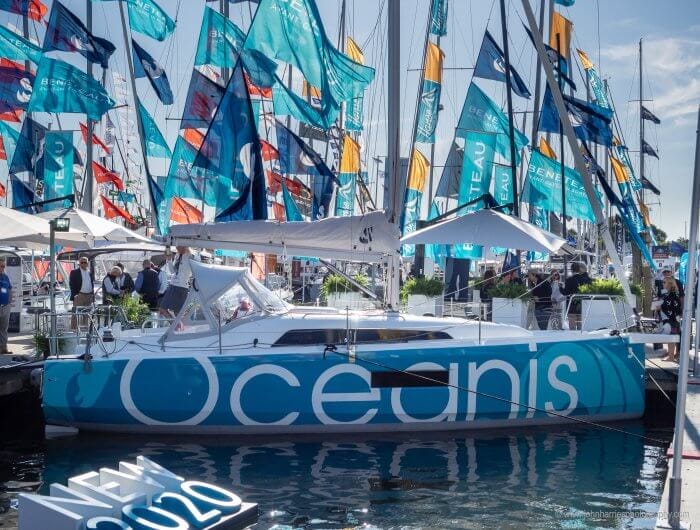

Beneteau were showing their new Oceanis 30.1 and claim a price from US$122,300. That said, the show boat above was carrying a price of US$170,000.
And sister brand Jeanneau are on the smaller and lower price band wagon, too.
Keeping an Open Mind
It would be easy to let my well-known prejudices against this type of boat lead me to dismissing them out of hand, but I’m not going to do that, and will be writing more about the Oceanis in a future post.
In fact, I’m even thinking that now that Phyllis and I are cruising less on our own boat, it would be useful to see if we could arrange a short cruise on one of these boats. Maybe a charter at some point.
The problem being that all of the reviews currently available are from those who benefit most from Group Beneteau’s massive advertising budget. And, on the other hand, old salts like me tend to piss on anything Beneteau without any real experience. Be fun to spend some time addressing those two problems and really delve into the practicality of these boats for various usage profiles.
It’s a Real Need
Yes, I know, there are thousands of used boats around at a fraction of the price of these “cheaper” new boats. I get that. But we also live in a world where people have less and less time to delve into the intricacies of buying a second-hand boat without getting screwed, and less and less time to devote to DIY repairs and refit, even assuming they have the time to develop the necessary skills to do that work…which many (most?) don’t.
Bottom line, cruising needs a reasonably priced turnkey boat, even if it is just suitable for coastal cruising.
Multihulls
Many people assume, because of the boat we own, that I’m a multihull hater. Nothing could be further from the truth. In fact, I’m boat-type agnostic, as long as the boat in question fills the need it was designed for.
Based on the show, the multihull market seems to have bifurcated into two extremes:
Floating Condos
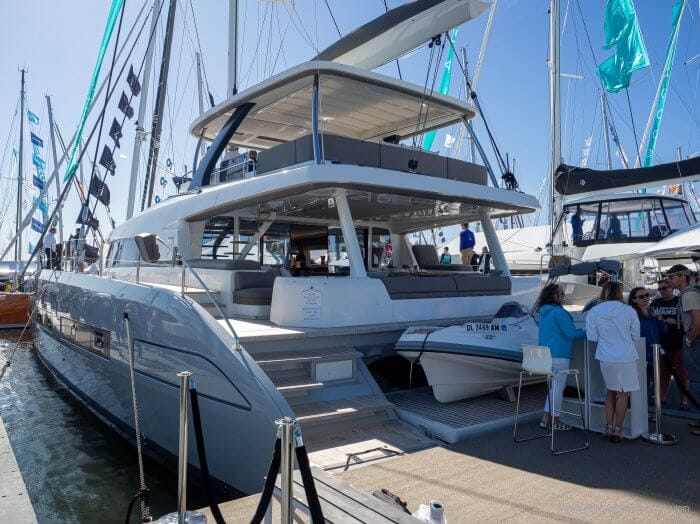
Clearly this is a sailboat in name only. I guess it’s aimed at the charter trade, or for some rich group to hang around in at one of the “in places”, while being waited on by a suitable number of crew—saw a bunch of these, did not bother to go aboard any of them.
Crazy Performance
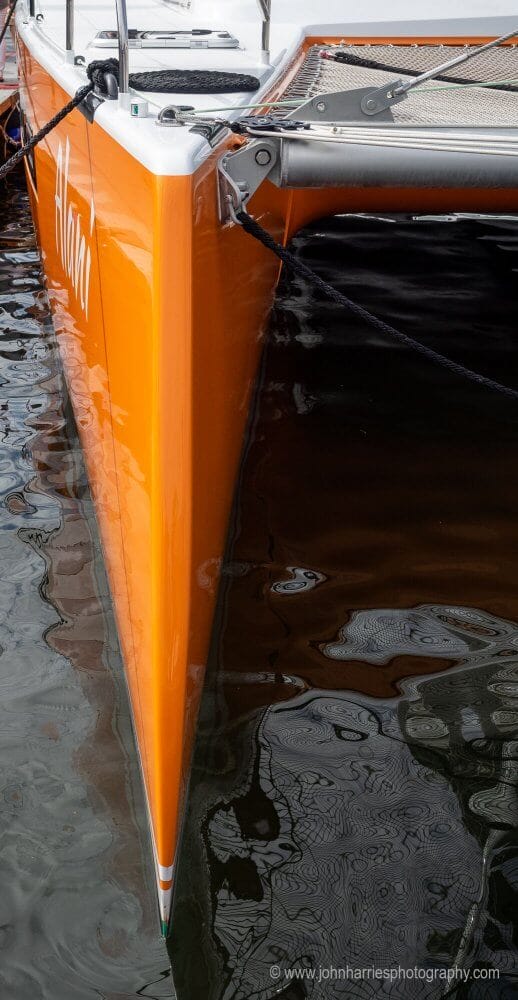
The other group were performance cats built in exotic materials clearly aimed at the “I have so much money that I don’t know what to do with it, so I need another status symbol” market. Think 2 million and up. Probably a gas to sail on, but not relevant to us so I didn’t bother to go aboard any of them, either.
An Exception?

On the suggestion of a member with considerable offshore catamaran experience whom I met at the show, I spent a couple of hours being shown around the South African-built Maverick 440 by Robert, one of the principles.
Very interesting, and I learned a lot. Not only about the Maverick, but also about crossing oceans in cruising cats, since the Mavericks, including the boat I was on, are delivered all over the world on their own bottoms, and several have circumnavigated. That boat will also be the subject of a separate article.
The Ultimate Trailer-Sailor?
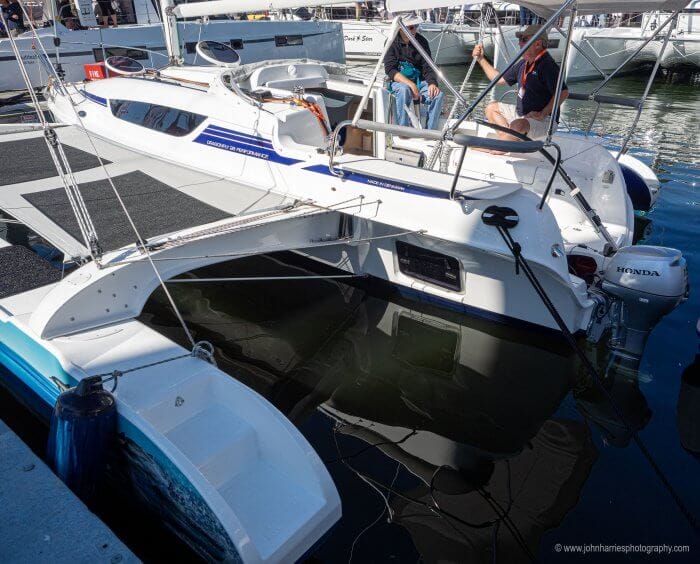
I spent an interesting hour on the Dragonfly 28. This is clearly a boat that will sail fast and be fun, but the really cool feature is that, with her folding amas (floats) and light weight (no ballast required), she can be easily trailered and launched, without even putting the trailer wheels underwater. And, further, a clever system allows two people to easily step the carbon fibre mast, or at least that’s what I was told.
This boat might be a lot of fun. After all, nothing goes to windward like a half-ton truck.
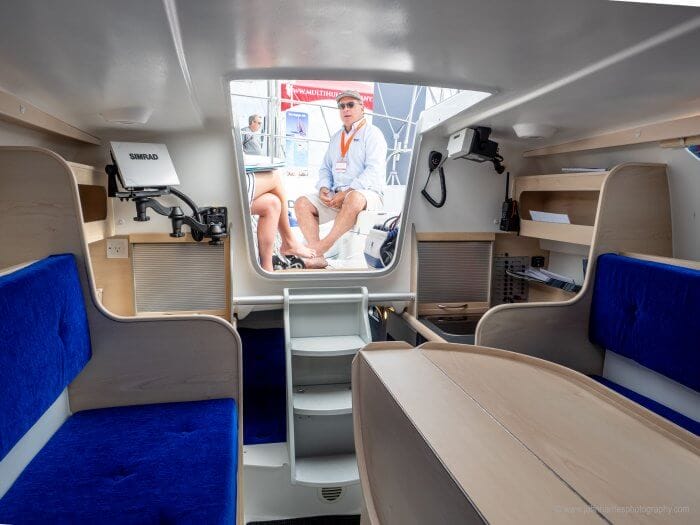
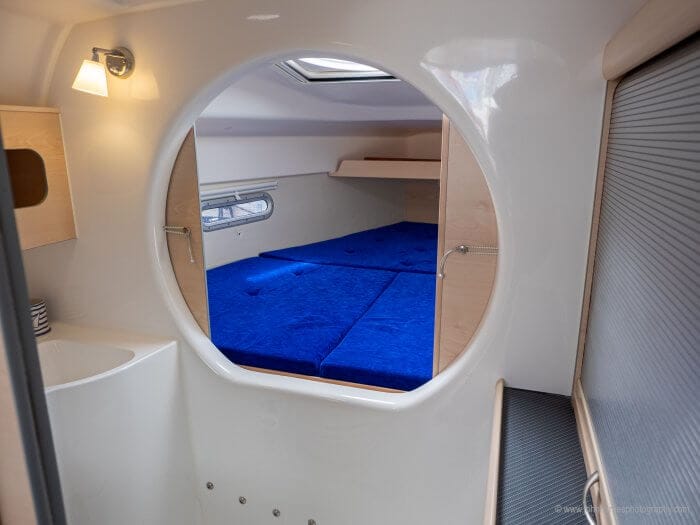
That said, we can’t have everything, so don’t look for a palatial interior. Living on a Dragonfly 28 is camping, at least by my standards, albeit with Danish-minimalist elegance.
Also, this is no budget buy. Think US$200,000 and up.
Not sure whether or not I will write anything more on this boat or not. That said, I was very taken with her.
Fast Is Fun¹
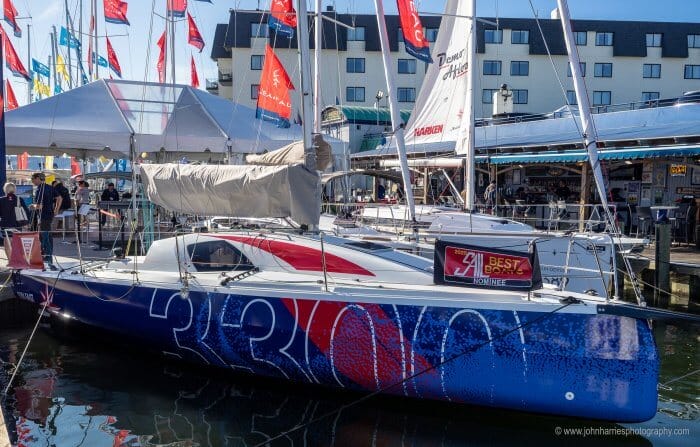
Talking of boats that go fast, Jeanneau was showing their new Sun Fast 3300. Not exactly relevant to this site, but I’m a sucker for this kind of built-for-purpose boat, so I went to look anyway.
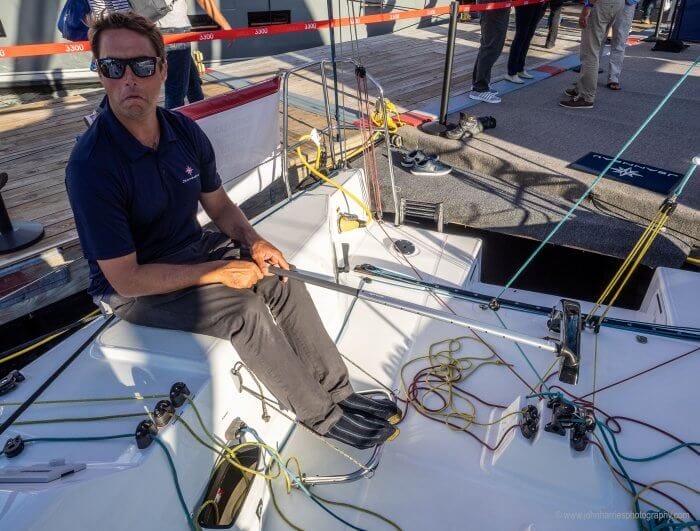
This guy modelling the very well-thought-out steering position—check out the adjustable foot rest and raised area to stop boarding water washing around your butt—has the enviable job of looking after the boat and campaigning it in double-handed races—the target market—around North America. Talk about a dream job. He and I kind of bonded as us 505 sailors do.
I did briefly think about one of these as my retirement boat. Second Childhood would be an appropriate name, don’t you think?

That said, I suspect that if we did buy this boat I would be doing a lot of single-handing, since this is not exactly a cruising interior!
Although for single- or double-handing it makes a lot of sense—note the two seats for having a rest and a doze that are still close to the action, and with a view of the sails through the ports just above.
There’s a water ballast option, too, to make up for the lack of the big crew weight that these hull forms like.
Once again, this is not a budget option. Think a quarter of a million dollars once you add some good sails and an electronics package.
Still, what I think is cool is that, as the guy in the photo said, we are seeing a return to production boats that are all about sailing and having a total gas while doing it—got to be a good thing.
J Boats Take on Fast
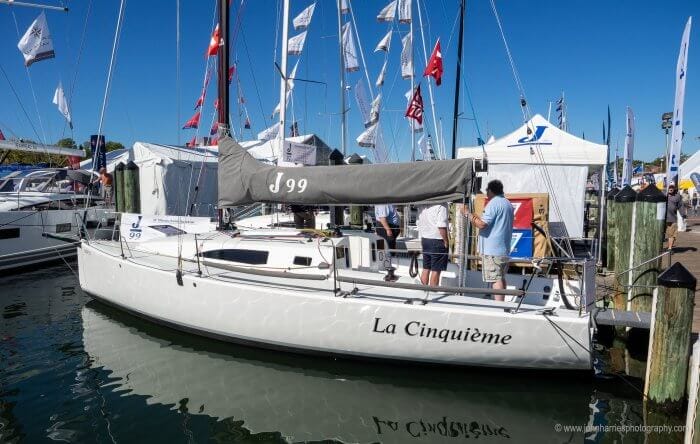
Here’s the Johnstone family’s latest take on the same concept, the new J99.
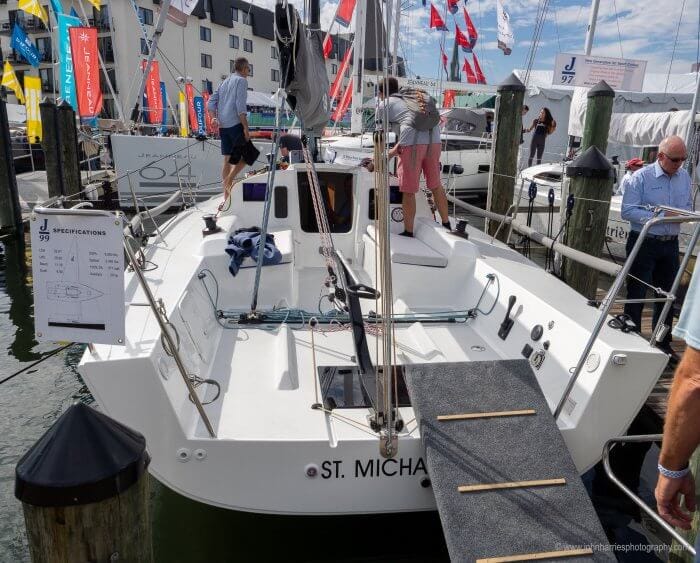
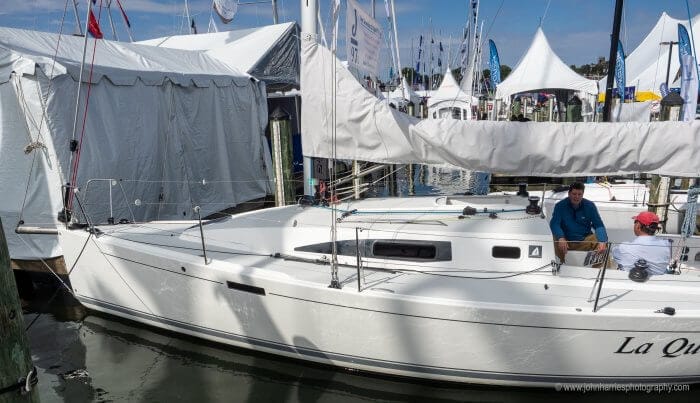
And for those who don’t want to be quite that hard core, here’s their J97e.
Alan Johnstone, the designer, explained to me that the first is their racer/cruiser and the second their cruiser/racer. Does it make sense to have two boats in the line so close in size and type? Never underestimate the marketing and design savvy of this family who have managed to remain in business and stay relevant for some 40 years. Both Js come in around US$200,000.
Relevant?
Talking of relevant. I’m sure many of you are starting to get pissed off with this digression into fast light boats. But wait a minute, before you head off toward your Westsail 32 mumbling “John has lost it and sold out”, think a minute about the future of sailing.
Today, the young people who have the money to sail offshore, often, probably mostly, don’t have much time, so easy to buy, easy to maintain, fun and fast boats like this surely have a place. I think so.
Share?
All very well, but still a lot of money, so what about sharing a boat split say four ways? That could be some serious fun for US$50,000—just settling for a small car rather than a fully tricked out SUV would pay for half of that.
Say own it for 5 years and then sell it for $100,000. That’s a $5000/year capital cost. Add in $2000/year/owner for maintenance and we are at $7000/year. Not chump change, but doable for anyone with a decent job and a yen to actually sail, rather than just dream.
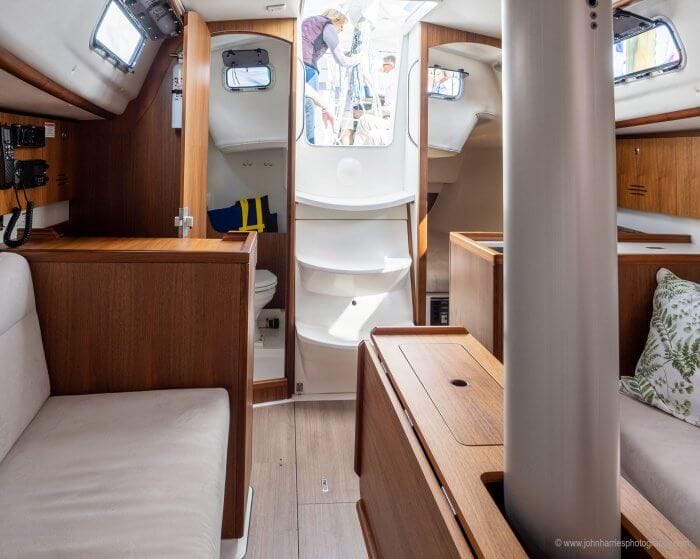
And it’s not just about racing either. Here’s the very nice interior of the J97e that would serve a young family well for weekending, or even a week or two coastal cruise.

Heck, even the balls-to-the-wall J99 has an interior an order of magnitude more comfortable than the first boat I cruised on, a Sea Sprite 23.
And if US$7000/year is too much, how about a second-hand J105 for half that?
Sure, none of these are ocean going, but doing a shared ownership of one now might be a hell of a lot more fun than spending years pining for an unattainable Outbound 46, or spending thousands of hours and dollars fixing up some old 40-foot cruising boat.
And one thing I can guarantee, anyone who spends a few years owning and sailing one of these fun speedsters, particularly if they race, will be a far better sailor, and far more comfortable on the water, than someone who has spent years stuck at the wharf or in a boatyard doing an endless refit.
Worth thinking about.
Still Too Much Money?
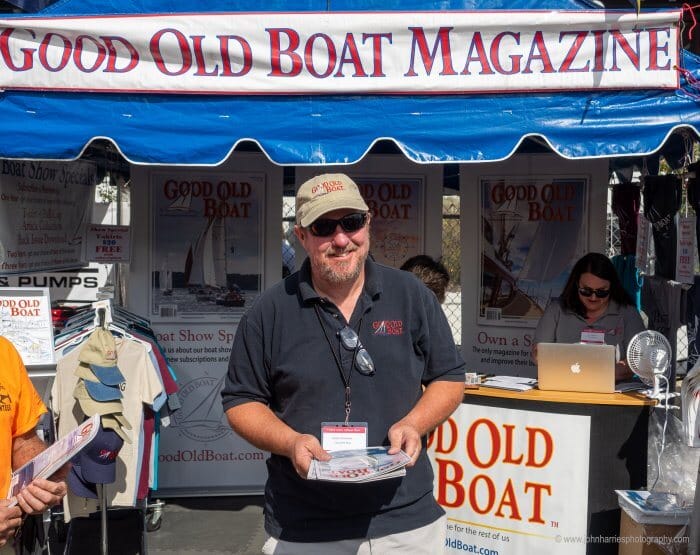
I had lunch with Drew Frye—AAC commentor and writer of about half of Practical Sailor magazine—and this man, Michael Robertson, new editor at Good Old Boat magazine and a real live ocean cruiser in his own right. Drew and I were bemoaning the state of sailing and lack of young people coming into it when Michael offered up a ray of sunshine—he seems like that kind of guy.
He said that he is seeing a new trend: There is so much cheap classic plastic out there that it’s now possible in California, where he’s from, to buy a functional 30-foot sailboat for $1500 that will take a couple out for a weekend, and even as far as Catalina Island.
Sure, most of these boats are crap. But the owners are still having fun, and learning how to take care of and sail a cruising boat. And, best of all, they are showing their contemporaries that sailing, and even coastal cruising, is, in this way, more attainable than it’s ever been—my Sea Sprite cost 3 times that, in today’s dollars, for a tiny 23′ boat.
That said, the key to keeping an option like this attainable and affordable is to not try and turn a sow’s ear into a silk purse.
Anyway, I’m definitely going to be thinking and writing about these options more over the next year or so.
Coming Next
Of course, I saw lots of gear, too, so that will be the subject of my next article about the boat show.

And we have not forgotten those of you interested in motorboats. After the boat show, Phyllis and I got to go on the maiden voyage of a SeaPiper, so we will have a full report on that.
Share Please
We published this report outside the PayWall (Free), so please share it with your friends using the buttons below (scroll down). Thanks.
Further Reading
- How to Buy a Cruising Boat Online Book
- Better Offshore Motorboats Series
- Getting Out There Cruising Online Book
Comments
Have you managed to get out on the water in one of the ways I wrote about above? If so, tell us about it. Ditto any thoughts you have on the boats I wrote about.
¹Thanks to Bill Lee

Maybe it is time to spend a couple of weeks chartering a beneteau (e-a-u) – either an Oceanis or a small Lagoon in Polynesia… 😉
I have owned Amel , Beneteau and Hallberg Rassy.
Guess the one I don t think is a blue water cruiser although probably ok for week charter.
Quality has a cost the price ratio is 2/1 or 3/1 when new and still in that ratio after 10 15 years.
If your budget tight go for a smaller well built blue water cruiser and keep away from the production grid inlay boats.
Denis, not sure I understand your advice to would be boat buyers.
Are you advising someone who (say) bought a new Hallberg Rassy 48 for 800K USD in 2004, which by your ratio is now worth approximately 400 KUSD, maybe a bit more, would be in a better position than someone who spent around 350 KUSD on a Beneteau 473 in 2004, that is now worth only 150 KUSD ?
A typical 2004 era 473 example by the way: https://www.yachtworld.com/boats/2004/beneteau-oceanis-473-3145627/
Having sailed offshore on multi-week passages on both these yachts from NZ, I am pretty comfortable saying both could and HAVE taken their owners safely around the world blue water cruising. But one would have left its owner with $200 KUSD to invest in (say) a commercial property, which with 50% gearing would probably be worth more now than both boats put together – and be providing a decent cruising income.
Both yachts are fine vessels, each with their own pros and cons. Surely though, the Beneteau buyer would have enjoyed the better investment? Oh, and guess which one put the whole crew off their food (worse for some) for our first week on passage? My first time ever, on a boat or ship in 50+ years, having the high seating position in its centre cockpit and a rather distinctive motion.
Br. Rob
(disclosure we own a 2003 B473 and commercial property).
Sorry, got my figures a little wrong. New HR 48 probably around 600 KUSD in 2004, (I was working up from used price today), so delta would have been $250K. Pretty sure the B473 was around $350 KUSD though in the USA.
Rob
Hi Rob,
That’s certainly an interesting and innovative way to look at it for the new boat buyer.
Seems to me that the whole point here, and what I realized at the boat show, is that there is a whole different analysis that needs to be done for the new boat buyer. Sure, I have never owned a new boat, but that does not necessarily make it a bad idea.
On the other hand, as soon as we flip to buying second hand the equations are different, I think, since buying a second hand HR48 might be a much better deal over time.
I’m not sure that makes sense either John,
The HR 48s are still much in favour with their buyers and rightly so. So they are fetching around 400 ->450 kUSD for a good 2004 Mk1 example (if you can find one), which as Denis intimated is really, very good. The Beneteau 473s haven’t held their value so well relatively, but I wonder if this is a result of fashion or function? My hypothesis is the reason for B473’s at this value-point is that busy, successful Beneteau owners attracted to the no-fuss, easy care Beneteau style yachting, also want the latest styling – like with cars perhaps?
As Denis notes, the Beneteau 473, 423 and 393 were better built than their previous iterations (and in my view, the newer ones too) so both yachts are going to last a lifetime John, but the B473 depreciation “hockey stick” curve has flattened out, the HR 48 one has not. Over the next 15 years, I would expect the depreciation on the B473 to be in the 10’s of thousands, the HR48 in the hundreds of thousands.
Anyway for whatever reason, the gulf in second hand values is still around 250 – > 300 kUSD today for good, non-charter examples. Invest that $ delta, in a sound commercial property 50% geared and I would wager a fine bottle of red, you would be far better off in 15 years time than having bought a 2nd hand HR 48 at today’s price.
Oh by the way, the B 473 sails way better than a HR 48 IMHO having tried both. Plus you can find one relatively easily without that horrible in-mast furling which HR seemed to fit as standard, but Beneteau fitted as an option.
John, why not both escape your Canadian winter for some cruising and walking in the beautiful Hauraki Gulf Islands, bare-boat or with Jenny and I (your choice)? Then write-up an article on a left-field, second-hand option so you could make an informed assessment whether a budget production boat could be a suitable offshore capable boat? Genuine offer.
Br. Rob
Hi Rob,
What a loverly invitation, thank you. As it happens we have been talking of a trip to NZ (my mother was a kiwi). It won’t be this winter, due to other commitments, but it may easily be next. Either way, I quite agree that I need to spend some time on a Beneteau, ideally an older one, and one of the new ones, to round out my knowledge—love ’em or hate ’em, they are a huge percentage of boat stock and ignoring that makes no sense.
On the HRs, I think that one thing that is working against the brand on the depreciation front is teak decks which have, in the last few years, switched from a desirable feature to exactly the opposite. That said, I’m pretty sure that it’s a very well built boat.
Hi John
I delivered a 10 year old HR down the Pacific Coast to SF that was an exact sister ship to the one John Neal has so successfully operated as a passage sail training vessel. Not that it is a bad boat—far from it, but we did manage to rip all the undersized blocks off the traveler, and anyone you or my height will find the forward sea cabin uninhabitable and the teak decks a $$curse of the devil. While I have always admired John N for creating a much needed niche in the sailing world and using it to take him all over the world I think that there are other boats better suited to a program like his. And I think a lot of that 400-450k that used ones fetch contains a large helping of fashion premium.
Hi Richard,
Yes, I have to say the boat would not be my first choice either. That said HRs do seem to have served John and Amanda well.
Haha, small world. Bring your bathers – the water is a bit warmer down here than in Nova Scotia.
And I forgot the depreciation impact of the HR teak decks – good point.
Rob
Hello,
The building process of the recent Beneteau’s post 2007 is a clever industrial procedure using CATIA to make things light and as cheap as possible. The finished product is well suited to the market they are aimed at.
I feel the 423 473 were better built than the more recent ones.
The list made by John Neal is interesting information.
Regards
Denis
Hi Dennis,
But what if you have some money but don’t have time to learn enough to buy a second hand boat safely? Or even just want a new boat. It’s an issue. Also note that I never said that I thought a Beneteau was a blue water cruiser. Rather I committed to keeping an open mind to the brand, particularly for other purposes.
John
I recently visited the Southampton Boat Show – our version of Annapolis, I would guess. Just the one day. First in, last out. Not the leisurely opportunity to browse at leisure you had. So mine is not a complete and certainly not an unbiased riposte.
I went aboard several of the Beneteau Oceanis’s there. From the outside they are striking and imaginative looking vessels. In this country IKEA is used as a pejorative term. But their cupboards do open and close efficiently. Not so the Oceanis show boats. The opportunity to be thrown a long way across the cabin in these designs, in any kind of sea, was plentiful. But maybe not too dangerous. If you remember the bar fights in the old cowboy B movies the furniture always obligingly collapsed as the participants were propelled into them and I’m sure the same would apply here. Nobody would ever get seriously hurt and everyone would get up, none the worse and sail happily ever after. By comparison IKEA furniture is pretty well built and Swedish and you wouldn’t want to crash into it.
I was shocked by most of the offerings. Most of them looked like mobile homes that the builders had strapped a mast and a keel to.
There were couple of Hallberg Rassy’s and a Swan but they didn’t look too great either unless you wanted to go to sea in a condominium. Also a Discovery, but I have helped deliver one of them…
From what I saw there were only two serious sailing boat builders at the show, the newly reborn Sweden Yachts, who were showing a 10 year old 42 ? and Rustler – a 37 and a 44, the 44 having a not quite right centre cockpit. Apparently the 42 is the one to go for.
If i were a newly minted young captain of industry, who came from a knowledgable sailing background,my options would be seriously limited. I would be looking further afield. Contrast that to 20 or 30 years ago when choices were far more plentiful.
By the way, that Outbound looks dreamy. And the Jeanneau Sunfast 3200, which was at Southampton, rocks.
I do try to keep an open mind but a painful history of wishful thinking does now hold me back.
Hi Mark
LOL
About 15 years ago I was asked by a client to accompany him on a walk through inspection of a boat that had caught his eye. Eye catching it was indeed, having been penned by German Frers, one of the best artists in the business. And being one of the “highly respected” First Series Beneteau 456’s that were supposed to be heads and shoulders above the standard Bendys, I was looking forward to a happy marriage between a beautiful model and my client. The first thing I usually do upon coming aboard is pull up the floorboards. Nearly choked to death laughing when I saw the mast sitting on a piece of bent metal hardly thicker than cardboard that spanned the area between two ribs.
Hi Richard
Yes, I had heard great things about the Frers Firsts.
I went aboard a 456 last year. Water squelched from under the teak bridge deck as I made my way below. All the floors creaked and squeeked loudly as I walked through the boat. I imagined trying to make my way around at night in harbour as the rest of the crew tried to sleep.
Still they look great, don’t they ?
I, also looked at a First 405 last week. Very nicely put together. The forward facing aft toilet was seaman like. The 7ft 2 in draft wasn’t ideal. And should I have been worried by being able to peel rust off the keel bolts with my thumb nail ?
Hi Mark,
I think keel bolts are a much underrated worry on any boat of this age, unless they are bronze into lead. If I was planning to buy a boat like that I would budget to drop the keel and replace the bolts, and negotiate the price based on that.
Hi Mark
re First 405
Naa– you should have been worried about the differential shrinkage rate between the liner and the hull as they sat around in the factory waiting to meet each other, and how much sticky poo was used to bond them together, and what that void was filled with when the iron keel bolts were used to squish the liner and hull skin together and hopefully hold the keel on.
Hi Mark,
We had our on water NZ Boat show this month and I too spent a long day happily browsing boats we couldn’t justify and looking at gear we didn’t need – loved it of course. I was given the grand tour of the new Beneteau Oceanis yachts (as a Beneteau owner their sales guys are ever hopeful) and I thought they were beautiful. I didn’t open any cupboards – what’s the point if you aren’t buying? But I did focus on some great innovations. I loved the substantial articulated dinghy davits that cleverly disappear into the transom when offshore, but come in to play around the coast. I swooned over the beautifully moulded tracks for their self-tacking jibs and their latest 7/8 rigs and the beautifully shaped and robust bowsprits with integrated anchor leads, ready for a modern A-sail. I loved the helming position with all the halyards and sheets right to hand, which allowed two full-length day-beds, one each side of the companionway – perfect for the skipper to snooze on under the elongated dodger whilst a nervous first mate stands a watch.
A sailing friend owns the latest generation Oceanis 60 and previously owned the 52 (I think). I met him on board one at the show. He shared what he loves about his new boat – in short, absolutely everything. Would he know much about boats? Should do – until recently, he was the owner of Doyle Sails which now owns Doyle Sails world-wide and has been a sailmaker and offshore racer all his life. His boat before the Oceanis 52 was a Beneteau 47.7 race boat that he extensively campaigned, including full crewed trans-Pacific and two-handed round NZ races which can get pretty hairy at times. As he puts it, why sail at 6.5 knots when you can be doing 8-9 knots upwind and 15+ downwind in comfort?
Personally, like you I don’t like the Ikea look, nor the large ports extending to the waterline – I think that’s plain daft. I also think the boats are beamy for the distance between hand holds, but with Beneteau construction you can nearly always dismantle things with a few screws or bolts and add things similarly. Remember most of these yachts won’t leave port very often so with budget boats (and the 60 is a budget small super yacht under $1 mill ?), they won’t add stuff most owners won’t use. Some of the new Hanses and x-yachts were pretty cool too. Oh and the Jeanneau Sunfast is of course a Beneteau brand.
Mark, I actually think today’s buyers are spoilt for choice – but there you go. Congrats on the rugby win last night by the way – your side were mighty.
Rob
Hi Mark,
I too struggle with keeping an open mind on these new boats, and like you the Outbound was the only boat that appealed to me personally.
That said, Beneteau do sell a lot of boats, so I’m trying to understand that better than I do now.
Dear Rob
I didn’t mean to step on your toes re Beneteau. There’s no doubt they have done an amazing job of opening up the sailing world to more people. And who didn’t enjoy the sight of the young crew of a French yacht doing their ablutions over the side of their boat of a morning. And those boats are seriously fast.
There’s a couple of meaty looking 456’s on Yachtworld in the UK at the moment for not a whole hell of a lot of money. I just need someone to hold my hand and tell me “down the line this isn’t going to hurt”.
Hi Mark, haha, no toes broken, but every boat hurts – it’s just how much?
If it were me and budget a concern, I would shrink the boat slightly and stretch the budget slightly, to a 423, nice one here: https://www.boats.com/sailing-boats/2005-beneteau-423-7163784/?refSource=standard%20listing
Great boats, ask anyone that’s owned any one of the Oceanis 393, 423, 473 range. Lose the old genoa and replace with a high-modulus 100 or 105% jib and a code zero combo to go offshore.
br,
Rob
Michael’s point about cheap classic plastic is one we’ve seen here in Ontario, too.
A quick look at Kijiji suggests that $2,000 CAD (about $1,500 USD) and a moderate tolerance for clean-up work would get you a choice of a Grampian 28, Northern 25, Tanzer 26, Catalina 27 (yes, I know….) Cranking the budget to $5,000 gets you any of the above in mostly-free-of-mice condition, or maybe also a Mirage 27, C&C 30, Shark 24, CS27, and several other good respectable designs in tired-looking, but fully usable, condition. Nothing you’d take offshore on passage, but quite serviceable for lake and coastal day-tripping.
At this price point, the CapEx is effectively immaterial, being only about 18 months worth of docking, hauling, and winter storage fees on a boat that really can’t depreciate much further unless it literally falls apart and sinks, and so should be able to go back up for sale at any time in the next 4-8 years for about the same as you paid for it.
Hi Matt,
Great to hear. Thanks for doing the research. The C&C 30 is a particularly sweet little boat, and amazingly fast with a good functional layout below.
And a very good point about the end of the depreciation cycle.
I sail (until spring) out of Toronto where there are dozens if not hundreds of 25-50 year old Good Old Freshwater-only Boats for sale at ridiculously low prices. Below 30 feet LOA, you are more likely to pay more for the first year’s dockage than for the boat itself, which may be in perfectly good condition, having had a repower, a rerig and a rewire over the decades. I sold a 33-footer for $5000 Cdn. in 2016 in such a state and see it most days at its mooring in my club. The new owner just replaced the original rudder with a stainless steel replica. Not my choice, perhaps, but not my boat, either.
The upshot of this is that aspiring sailors can get into sailing cheaply in terms of the upfront costs and can get five to 10 years sailing under their belts before committing to either an ocean-grade used boat or something new. That’s a distinct difference from when I bought our first boat in 1999.
Hi Matt,
I know the Catalina 27 isn’t exactly high performance, but what’s the eyeroll about? I’m genuinely curious what the wicked salty people around here think of them.
-James
Most of the Catalinas I’ve seen are rather cheaply built, with a lot of structural shortcuts. They are decent designs, and perhaps they have some sturdier models that I haven’t seen, but the ones I see around here are usually missing things like cleat backing plates, and have a too-thin hull that’s often riddled with fractures from docking accidents.
There’s a reason that the Catalina 30 is about the most popular “good old boat” out there. It’s the same reason the Dodge Caravan is the most popular grocery-getter. But there are plenty of situations in which you would not take a grocery-getter, and there are plenty of sailors who never (if they can help it) get into the sorts of weather or seaways where the flaws of a cheap, popular design maximized for 10-knot fun wouldn’t be revealed. That is not a criticism, just an observation. Most sailors, most of the time, prefer fair weather and comfortable accommodations. That’s what most recreational boats offer: they “recreate” amenities ashore.
I see what you mean. Mostly a coastal vs bluewater sort of design/build philosophy. I see tons of them around here (SoCal) but I doubt any of them get more than 50 miles off shore. (unless someone has the convictions of Matt Rutherford).
Any comments on the latest Island Packets, both in seaworthiness and construction quality? Same questions for older IPs. I notice this brand is not discussed much around here unless I missed past posts. Thanks
Hi Richard,
Sorry, my prejudices showing on that one. I just can’t get excited about the Island Packet boats, but I’m certainly not saying they are bad boats, just that I don’t like them. To me, a full keel with attached rudder just does not make sense in 2019 since fins with separate rudders just sail and track better. at least if well designed. I think the idea that full keels were better got going in the days of the IOR rule which produced fin keel boats that were truly horrible, but that was a function of the rule, not the type.
I know that’s not the “accepted wisdom” particularly on forums, but it’s true. If you are interested in why, have a read of Bob Perry’s new book, particularly since he has designed both types:
https://www.morganscloud.com/2019/05/13/learn-from-the-designers/
I see: the ex-racer coming out 🙂 and scorn pretty from pretty much everybody else 🙂
Hi Richard,
Actually not the ex racer coming out, but rather the long term voyager. A hull form like the IP is poor upwind (not bad at all on a reach), particularly once the waves get bigger, as they do offshore. Poor to the point that little progress will be made. And sooner or later, most any even slightly aggressive cruisers will be faced with a multi-day offshore passage upwind. Doing that in an IP, even motor sailing will take as much as double the time it does in a better performing boat. And during that time it is likely, at least in the midlatitudes and above, that there will be at least one gale that the faster boat may be able to dodge completely by competing the voyage on a single weather window. The point being that lack of windward ability in waves is not a trivial weakness.
So yes, I’m prejudiced, but it’s prejudice based on experience and reality, as well as a pretty good understanding of hull forms. So, while it’s perfectly sensible for someone to accept that performance reality and still go ahead and buy an IP, I would suggest it’s not a good idea to deny the reality.
Hmm convincing explanation that I can relate to my own boat behavior thanks.
Hi Richard,
Speed as related to voyaging, and voyaging boat design, is an interesting subject that really does not get enough air time. I’m thinking I should do a piece on just that.
Hi Richard
Back in the day when I owned a full keel sailboat of similar size as the IP’s I always wondered why they were so much slower. Then one day I was sailing back into Kehi Lagoon in Hawaii when I spotted one seemingly completely intact but slightly aground on a rock. Since there was no swell and very limited tide I expected that it would be soon towed off. Once we drew close enough to see the other side of the boat it was obvious that that wasn’t happening. The entire side of the Packet was missing as if prepared for a cutaway display at a boat show. Enough said.
Hi Richard,
Friends who owned and cruised IPs felt like they were good boats who took care of them, but all complained that they were slow and that they packed a tremendous amount of systems in them at the expense of access when they needed work.
My best, Dick Stevenson, s/v Alchemy
Hi Dick,
Yup, that’s pretty much the way I read it. That said, the people that own them seem to love them
Hi John,
And I was always impressed by the involvement of the factory and its responsiveness to its customers.
At the Annapolis boat show, the IP croud was always well responded to and the factory threw a nice party where “prizes” were given out for achievements the previous year by the boats and their owners. All very community building.
The Valiant factory (my boat), by contrast, threw a party with a spread from the least expensive deli, no introductions of new owners nor acknowledgement of achievements by Valiant owners the previous year.
Guess which boat is still in production?
My best, Dick
Hi Dick,
Good point! Marketing counts for a lot.
We owned an IP38 for several years with the intention of her becoming our long-distance cruising boat. We picked it up in Mexico in 2009 from a couple that used it mostly as a floating condo, but took great care of the boat.
We sailed her in the Northwest for two years, and our favorite joke was that when we used the staysail, we gained .5 knots. And when we furled the staysail, we gained .5 knots. She wasn’t a very fun boat to sail. Also, as a couple in our 40s, we were by far the youngest IP owners in the Northwest. It felt kinda nice to fell relatively young again 🙂
But what did it in for us was the horrible, nearly nonfunctional galley. Also, the single aluminum water tank that required removal of the entire sole to replace it because, well … a freaking aluminium water tank. And ultimately, the fact that the shroud chainplates were glassed into the side of the hull and impossible to inspect or replace without ridiculous surgery.
I will praise the factory support and the willingness of fellow owners to share their knowledge. Never felt alone in working on the boat.
Still, because we got such a great deal, we actually sold the boat at a profit. Seriously. When does that every happen? And the couple that bought it has been happily sailing her around Pacific Mexico for years. They love the boat.
We now have a Passport 40, which we love and treated us well on our recent journey to Alaska from Seattle. She’s the boat that will take us to Mexico and beyond. And yes, I’ve been refitting her slowly for the past few years, but I actually enjoy the projects. And the many great idea we have gotten from this wonderful site.
Hi Martin,
Thanks for the report on the IP. Very useful.
And thanks for the kind words on the site.
Believe me, as I’m sailing a Dana 24 I know the meaning of ‘slow’. I fully understand the rationale that faster sailing means safer passages, although as a coastal cruiser this is less of an issue IMO, since I can avoid playing roulette with an incoming weather system. I confess I sometimes cringe at being the slowest boat around, but when I’m reaching the lobsterpot minefields of Maine, I keep congratulating myself for being able to sail or motor straight through without concerns: but this must sound anecdotal to people sailing farther. I feel attracted to IPs by their lines, the apparent stoutness, and the protected rudder. I know that much of their price must come from luxurious joinery and accommodations, and was wondering if the construction quality matched this. Also, I read that the latest 345s had better sailing performance.
I’m looking forward to the comparison of the Garcia and Boréal. I looked at both extensively, sailed both and bought the Boréal 47… on my way to the Canary Islands in 3 weeks. Antigua by Christmas.
Hi David,
First of all thank you for having chosen Boréal over any other boat. We are proud and happy to have had the chance to build your “Beyond the Blue”… It means a lot to us that you have taken the time (and invested the the money) to do a thorough analysis and sail both boats, rather than just succumbing to the luring sirens of marketing (which in the most obvious way is not our strong point)…
Last two years Charlie Doane gave us the chance of exposing his Lunacy at the Annapolis Boat Show (one more time : thank you to him !). It was for us the first time being at an american boat show and we took the time to do what John did : looking around, trying to have an open mind. During the show we discovered the Outbond and I had the chance of spending more than 2 hours on board of the boat being allowed to open every single locker and floorboard, discussing with the people for the yard (good people !!!) ….
Of course the choice of the building material and the architectal concept are different but I had the feeling that both yards and boats were very close in philosophy, general approach, technical solutions… This impression was confirmed by at least a dozen of people visiting both and saying to us : “Outbound and Boréal, the only two boatbuilders of the show building no nonsense real offshore live aboard sailing boats…
We wish you and Scarlet a very nice crossing. onse step closer to your home port, Vancouver.
Jean-François
Hi Jean-François,
Good to hear that the Outbound appealed to you too. Always nice to have a gut feel confirmed by someone with your experience and boat building knowledge, which I do not have.
You’re welcome Jean-François.
As you know, these were not the only two manufacturers we researched but were the last two. Thank you for you kind patience with us as we stepped into a realm of building and sailing that we had not experienced before. The entire process was magnificent albeit stressful but the stress came from our ignorance. You and your staff helped tremendously (as did Colin Speedie). The first 1500 nm has been magnificent… What a smooth, quiet, easy motion ride.
Hi John
Great job of browsing the boat show offerings available in the present era. Everything in the menagerie reinforces my belief that I would never buy a new sailboat!
Now there are boats like the Boreal that I would buy if I had a million dollars of walk around money, but that does not mean that even such an exceptional boat is a good investment. Bundle all the sailboats on display at Annapolis this year, put them through typical use for five years, pay moorage and loan interest, and the median resale value will be about 50% of the purchase price. Hard to find a major capital investment that is that bad! On the other hand if you search out the rare used boat that was built right and has been loved over the years it is entirely possible to own it for a decade and sell it for the same $$ you originally paid for her.
Of course there are other fanciful investments that are far better than any yacht. Before I caught the boat disease I used to own a exotic automobile restoration shop. One of my clients brought in a ratty 1955 300SL Gullwing Mercedes for a complete frame-off restoration—- a 2200 hour job that paid for my first ocean going sailboat. When the Gullwing owner decided to trade his wife in on a newer model I arranged a sale of the 300SL to a Swiss museum for 100k. (about the value of a high end 40-44′ sailboat at that time.) The Gull is now valued at 1.6 million.
Or another client’s 375 GTB Datona Ferrari that he bought for $20,000 and paid me a few thousand to repaint to the proper Red is now a $750,000 item. (and was great fun to test drive at 175mph on my favorite straightaway.)
Hi Richard,
I agree, no one sane ever called any boat an investment, and particularly not a new one.
Hi Richard,
May be I can help you 🙂
Or at least allow me to put te record straight
The standard price of Boréal 44 is just under 500K dollar (at the present rate…).
So even if you add all possible options we ever have made for our owners you do not come close to the figure you mention…
Disclosure to you : I accumulate the boat disease AND the exotic car disease…
… and, as I understand it, the few used Boréals that have sold have sold for very close to their purchase price.
Please, if you’re talking about J Boats the name is Johnstone, not Johnston.
Hi Reed,
Thanks, fixed now.
I have a 1990 Beneteau Oceanis 500 Clipper. A sturdy boat with stout gear. Looking at the new B50s at shows made me think the new ones are way less ocean worthy. To start with we have grips all over the place inside – just stick out your hand and there’s something to hold on to. New ones don’t and I’d hate to fall allmost 5 meters (her beam is 4.75 mtrs) from one side to the other. I actually think buying an old one gets you a better boat – from the days B’s were made for true sailing – as long as it was taken good care of. Mine was. And it is a hell of a lot cheaper to buy!
Rob
I have a MRI scan of a huge bone spur on my right elbow that is a souvenir of a November gulf stream delivery of one of those fashionable deck salon toy boats. My advice to anyone buying one— buy plenty of beer and never leave the dock.
Hi Rob,
Yup, the pitch for a new boat these days is a hard sell to me too.
This supports my observation at various boat shows over the years that newer boats seem laid out by designers who’ve never been offshore. No sole hatch tie-downs, no handholds, poor access to critical areas and three metre “air gaps” I would hate to plummet down coming off a big ‘un. But clearly, that’s not “the market”.
Reading the article I had a hunch that it might trigger a discussion about “classic true ocean boats” and “new IKEA consumer boats”. I’m certainly no fan of cheap build quality, not always sold as cheap as the crap deserves, but I do think it’s worth considering that boats actually can be made better now than they were a couple of decades ago. Perhaps, on several important issues, most aren’t. There are signs that the consumerism is taking over some places, but that’s not inevitable.
Also, those that make great designs with great quality are normally priced accordingly, but perhaps that’s also not the only option. I quite literally hate all the gadgetry and “furniture” and just stuff all over on new boats. I can’t afford a new high end boat, but if I could, I’d never buy one of those one can find at shows. No way. The Adventure 40, developed here on AAC is a good example of a mindset that would produce a totally different type of boat that I would like. How many boat builders have that mindset? Almost none, AFIK… Pity.
Being a mainly multihull sailor with roots in racing, I too observe what you mention, the development into two seemingly extreme types. The “luxury floating houses” with their disgusting 3 floors or so, and the “fake supercars”, made too look fast but failing that by being stuffed full of expensive garbage so they’re too heavy. In my not so humble opinion, they’re both also a total failure in serving what the market needs. The same mindset i mention above would create vastly better cruising catamarans.
I’ve sailed Dragonflys since 1988 and used to know the owner Jens Quorning privately since we both raced in the professional Formula 28 class in the nineties. Dragonflys are great fun and good designs built with good quality. Some of them are really really fast, but most of them are mainly cruisers. Still, sailing one of these boats will normally make most sailors “tilt”. It’s such an amazingly enjoyable and rewarding ride. The idea of trailerable boats is also in general a very interesting one that I think the business could develop far better.
Hi Stein,
Great to hear your endorsement of the Dragonflys. I was certainly very taken with the boat, so it’s good to know from someone with deep multihull experience that I was not taken in.
The sad thing was that there was almost no one visiting the 28 at the boat show. And I think I know why: I was one of a tiny minority who when inspecting a boat actually spent any time on deck or in the cockpit. The vast majority immediately dived below. Given that, I suspect that cool sailboats like the Dragonfly will always be a niche boat, no matter how innovative the marketing.
John, I didn’t realize you started out on a SS23. That was our first boat and what fun it was…even if you had to decide if you were going to sleep on your belly or your back before slithering in to the v berth. And the “pretty” comments we’d get when we sailed into a crowded anchorage and drop the hook. We’ve since “upgraded” to an Alberg 30 and still have a pile of fun sailing an old classic.
Hi Steven,
Yes, my first boat with a cabin. We would happily spend a week or more at a time aboard. Loved the boat and even took her offshore around the research rig then positioned 28 miles to the SW of Bermuda. Probably not really smart behaviour, but we came to no harm.
From all of my reading, especially on this site which has so many deeply experienced people contributing, the ideal choice of boat is going to align with these broad criteria:
1. Most of us are going to be a couple who have ambitions at some point to sail offshore, or to the higher latitudes. First and foremost we need a safe, comfortable hull that is reliable, performs well, and has sufficient volume to hold the necessary gear and systems we need.
2. To achieve this it will likely be between 40 – 50ft LOA. The hull will need to be rigid and sound. This means a solid FG or metal hull, with a strong keel and protected rudder. Keep in mind you can change anything you like on the boat but the hull design; everything starts with this. If the hull does not suit your purpose, nothing you can do will ever make it right.
3. The smartest strategy is to look for the hull you want, is already been refitted well, but is now on the market for reasons beyond the owners control. In other words a boat that someone else has already spent most of the money on.
5. Then when had the boat we made a big spreadsheet, with every wish-list item on it, organised into three columns: Get out of the Marina, Get Sailing Locally, Go Sail the World. Every item is then allocated to one of the three columns; and this way I know what is important. Items on the first column will get us out of the marina; they are the most important.
6. The longer the damn boat sits there not sailing the bigger the time risk, the bigger the chance you will never go sailing. Keep this first column short, affordable and confined to the safe essentials.
7. The Get Sailing Locally column is where you can discover what works, what is really needed to live and enjoy the boat day to day. This column is where you put all your learning experiences, where you can track all the options and tradeoffs necessary to get the boat the way you want it.
8. Then put all the ‘dream’ boat items into the last column; many of these will be really good to have, like a JSD or watermaker for instance, and having them there will prompt you to make the necessary technical allowances for them as you progress … but the trick is to push as many expensive things out onto this column for as long as you can. Besides the longer you wait the more likely a really nice bit of new technology will come along that will be much better value.
At least this is the method we are using, and so far I’m finding it simple and flexible. It’s saved me from several bad mistakes already. For instance I was all set to get a new anchor winch, but I put it off into the third ‘dream’ column and didn’t order one when I really wanted to. Then months later I realised I could rebuild my existing winch for a fraction of the price and get a better result!
And surround yourself with good supportive people, people who want you to get out there. While there will be no single individual who can answer all your questions, there is no doubt the voice of experience can be a valuable sanity check.
Hi Philip,
All good advice, thank you.
Hi John and all,
I am still working on my ideas pertaining to this subject, but one of the complicating factors in evaluating sailboats is that safety, especially safety over time and offshore miles, largely, not exclusively but largely, comes with increased expense. And we are not used, or experienced, in evaluating our major expenses in life on risk level. Some few may buy a more expensive car because it is safer, but generally, I believe this to be rare. Mostly we equate expensive items with luxury items (sometimes described or experienced as an indulgence) and that is not the whole story when evaluating boats or the decisions going into one’s choice. Many of the expensive boats being discussed will be safe and reliable in middle age with a couple of ocean crossings under their keel and having endured the various mishaps that widely cruising boats find in their wake. That kind of longevity demands good design, good building, and good materials which adds up to expensive.
My best, Dick Stevenson, s/v Alchemy
Hi Dick,
Yes, that’s a very good point. One of the reason’s I would like to spend a week or so on a Beneteau is to get a feel for how the boat ages.
Dick… very valid point and exactly why I ended up in both the Garcia and Boréal plants… I have owned several boats, the last two were a Beneteau and a Wauquiez. I had both for almost 10 years each. Both accomplished what they were made for but both made me realize I needed something stronger with a better sea ride than they offered. Both boats received damage from hitting objects (logs… or as we call them out here on the west coast of BC, deadheads)… often you don’t see them until you hit… the damage to the fibreglass structure was significant enough (not threatening) to make me seriously reconsider an aluminum hull… and a design that would allow my wife to love sailing and want to come with me. Imagine a beginner, sailing the Bay of Biscay in 40 knots and loving it… she did.
The Boréal is a fabulously engineered vessel. We did not buy it because it was “luxurious” … I wouldn’t say it was. It is very nicely put together however I would say it is functional as opposed to luxurious, but having said that, it certainly is not spartan or utilitarian at all… it is very well designed and is as strong, comfortable and fast as she looks.
Thank you Boréal …
About the Beneteaus, from my cursory examinations in boat shows and documentation, it appeared to me that the Jeanneaus would be somewhat better sailors, and were better designed towards sailing. I am wondering what others think about this and whether there are differences in construction. Also I would like to know people’s opinion about the retractable keel/centerboard options offered by Beneteau and Jeanneau: I am always looking for solutions allowing shallower draft.
I chartered a Beneteau in the caribbean and they were OK for the program we had there: not so much sailing but moving the condo between snorkeling places and enjoying the large and comfortable cockpit for imbibing and socialization.
Hi Richard,
It occurs to me the Beneteau and Jenneau brands carry through a different design DNA into their ranges. Beneteau have been heavily influenced by the charter market which is driven by economy and durability. So steel keels (not lead) that can hit rocks and remain on (mostly). Economy, largely comes from mass production techniques and purchasing scale but you also have to understand you are buying a budget yacht and a budget geared to a charter company that is buying 100s of yachts a year, but also having to maintain them so tried and trusted is important. Furnishing is designed to take endless charter knocks and then be unscrewed or replaced where possible. Ultimate performance is not a charter requirement – so Beneteau’s tend to have shorter rigs (for steel keels) but easily driven hulls. And many Beneteaus perform pretty well – how many fully laden cruising yachts will continuously surf in trade-wind conditions at 13->15 knots with two finger helming, like they are on rails? Ours does and it’s an absolute blast. The key to this is easily driven hulls from top design companies – our hull shape came from Groupe Finot based on their winning Whitbread 60 design, scaled down to 14.5 metres and these companies can afford good designers.
Jenneaus came from the performance end of the spectrum. As I heard the story from an Aussie mate (and sailmaker) who was racing on her, the first Jenneau was an IOR boat (I think called Justine) that performed well and after the series, was whipped straight back to France and a mould taken off her. As you say Richard, I also perceive today Jenneau have stayed more on the performance side of the spectrum in yacht design. Taller, bendier rigs being one difference I noted at the boat show.
From the beginning Jenneau targeted the race / cruiser market with their main Sunfast brand and still do today. Jenneau added a range of more cruising orientated boats.
Beneteau on the other hand moved the other way into the race/cruise market with their First brand and it seems to me that as long as both race/cruise brands are treated as the lighter race boats they are and nursed by a race crew when needed, they are capable yachts loved by their owners.
When it comes to construction, I think it likely J&B are both now very similar, given both are owned by Beneteau Group, but probably also pretty similar to every plastic Euro produced boat. In around 2007 when vacuum bagging and sandwich construction was forced on the industry – this was a massive change. Almost overnight, hulls became significantly lighter and stronger, but their stiffness now comes from sub-frames and liners and local impact resistance is problematic and mistakes have been made. Let’s be clear, the Euro boat companies had little choice in this, forced upon them by EU health regs and competition. Since then, every production company (not just Beneteau and Jenneau) have struggled to make boats that will be durable offshore in the event of impact events like collisions or groundings. But I am hopeful the new ones will be better than the ones of just 10 years ago and continue to get better with time, experience and R&D.
Example from the auto industry: https://youtu.be/qBDyeWofcLY
Perhaps, just stay-away from Euro boats from 2007 -> 2015’ish for offshore use – just my opinion from what I have learned.
Rob
Hi Rob, just being a little pedantic, the keels on most European production boats including Beneteaus, are cast iron, not steel. This selection is solely for cost reasons, a lead keel actually has better energy absorbing properties in impact situations. Cast iron has a significantly lower specific gravity compared with lead which means the keel has to be physically bigger for a given weight. Bob Perry wrote about this extensively in his yacht design book.
Hi Alan,
That’s my understanding too, thanks.
We talk endlessly about which boat will perform better in survival storms but again and again we hear about crews being taken off boats in Mayday conditions. Then x number of months or years later the boat washs up ashore intact.
In the Fastnet storm nearly all the fatalities occurred in the life rafts. Nearly all the abandoned boats were recovered. Obviously one would have been better off in a Contessa 32, perhaps the wettest boat in history, where it would never have seemed a good idea to have abandoned a perfectly good boat to get into a dubious prospect like a life raft. An ill named concept at best. Nevertheless a less than perfect boat must always be a better prospect than an inflatable dinghy with a cover over it.
Then we come come to the ARC. An anathema to those who came before. And a catalogue of instances where people have abandoned perfectly good boats just because their rudders have fallen off. Repeatedly. Then they jump off and let their insurance companies take up the slack. So who pays ? Us maybe ? Well they do have their loved ones on board so in a choice between a sure rescue and and an uncertain and dicey adventure which one should they choose ? But turn that around. If you are are going to take your family offshore you should be pretty bloody sure and they should be sure also of the risks and rewards of what you are setting out to do. And on a milk run at the right time of year with predictable winds and currents and on boats that are permanently connected by an umbilical cord of radio and satellite technology to land based shore systems its astonishing that people don’t endure more often.
I have never had to make that choice so who am I to pass judgement ? But as they say in another world “if you can’t do the time don’t do the crime”.
Mark, I have never been in the situation to need a liferaft, and hopefully will never be. But one rule that I have heard so often always comes to my mind when the discussion diverts to liferafts – one must never step down into the raft, always climb up.
Which means “do not leave the boat before the boat leaves you”…
Hi Mark,
Yes, leaving a boat simply because of a rudder failure is a hard one. That said, it’s worth remembering that rudder failures can often be associated with flooding, if not immediately. Huge number of different scenarios here. For example, a broken rudder shaft on a spade boat can actually be a better scenario than on a skeg or keel hung boat. In the first instance the rudder is gone and out of the way. In the second it can often be crashing about as every sea goes by, threatening to tear the skeg off, or the top bearing out of the hull, and open the boat to the sea.
The point being that there are a lot of rudder fail scenarios where staying on the boat over a long period could be a bad call.
That said, I agree that far too many perfectly seaworthy boats are abandoned.
Hi John
A few real life scenarios to add to the hundreds out there—
Bob Perry’s signature design, the cold molded 2 tonner “Night Runner. Owned forever by Doug Freyer, a true sailors’ sailor. After the poorly constructed wood skeg fell off leaving the rudder intact, Perry asked Doug how it sailed. “Better” was Doug’s response. LOL
On the way to Mexico a few years ago a J boat racer/cruiser (a J 130 I believe) hit something, ripping the rudder out of the boat and sending it to the bottom with barely time for the crew to get into the life raft.
100 miles out from Bermuda after a typical November delivery passage one of my crew asked, “are we close enough to be rescued?” I made some smart assed remark and then looked the guy in the eye. It took a bit of talking to convince him that a helio couldn’t pluck him off the boat even if his American Express Card had a $250,000 limit.
Hi John,
Thank you for insisting on this point.
Before going on any off-shore cruise with a sailing boat one should check : what will protect my rudder in case of shock (single rudder versus twin rudder) and what happens if I loose my rudder ? For us at Boréal, having a single rudder protected by the keel and a real watertight bulkhead in front of the rudder post is one good answer… (My guess : The people of Outbond will give you the same answer…)
Hi Jean-François,
Yes, I agree. I have long said that twin rudders on a cruising boat are a bug, not a feature. It never ceases to amaze me the way the general boat buying public will adopt something as good, like twin rudders, without ever once asking themselves if that design is applicable to cruising.
Twin rudder… one of the design criteria that made us choose Boréal over Garcia and Hallberg Rassy.
The other was the AMAZING doghouse on the Boréal… in view of our eventual return to the west coast of BC … or as we like to call it, the best coast of BC… it is a God send! My wife stood her night watches in a t-shirt crossing the Bay of Biscay comfortably snuggled in the dog house.
Hi David,
I am glad you are so pleased with what sounds like a great boat.
As has been talked about in these pages, many of the labor savings devices and modern conveniences often demand more discipline on the part of the crew. Full enclosures and warm cozy doghouses are a real temptation to being comfortable, but I would want to suggest that the on-watch person resist taking full advantage of the comfort offered and always be prepared to go on deck and work the boat. For the Bay of Biscay, I would likely lean towards full foul weather gear (unless just a glorious and unusual BofB night) and a harness. Wearing less than that means that time must be spent kitting up or that there is a temptation to go on deck without harness and/or protective clothing.
My best, Dick Stevenson, s/v Alchemy
Hi David
Congratulations on owning a great boat! I agree that the west coast is the best coast, buy I’ve always heard it called the “Wet Coast.”
I’d say that’s a scenario that needs to be considered at the initial design phase. The hull and structural bulkheads should be designed to remain intact no matter what happens to the rudder. Surfing backwards at 14 knots with the rudder jammed hard-starboard and bent back 30 degrees? That is (and always will be) scary as hell, but it should not pose any risk of primary structural failure.
As far as I know, classification society scantling rules generally don’t account for that kind of situation. So, unless it was specifically considered by the designer, there *is* a risk. Am I correct in thinking that, in general, the best way to deal with a failure of this type is to drop a drogue or sea anchor to stabilize the boat and wait it out until conditions allow you to jury-rig something temporary?
I really hate the thought of breaking out the Last-Glimmer-Of-Hope Raft, normally reserved for massive fires and getting T-boned by freighters, because a rudder quadrant pin snapped…..
Hi Matt,
The best emergency steering after rudder loss solution I have seen is a towed galerider. It will take a long time to get anywhere, but it is doable:
We carry one all set up for just this purpose:
https://www.youtube.com/watch?v=vupIl68mCYg
Hi John and all,
I am far from sure about “best” but I have always considered the emergency rudder options such as the Monitor wind vane offers as the most appealing. I have not seen any field reports etc., but they sound like they would be far more effective at working the boat over time and distance than a drogue type option.
This appears to me an important area for gathering (and developing) info as the loss of a rudder all to often leads to the loss of the boat.
My best, Dick Stevenson, s/v Alchemy
Hi Dick,
I’m not all convinced that wind vane options will stand up over time. Just too flimsy for real steering loads. The exception would be gears that actually steer the boat, but the Monitor is not one of those.
Hi John,
Interesting and you are probably correct. These pieces of gear have been around for awhile and I have never seen any field reports: not even reports of a test run on a blustery day.
My best, Dick
Hi John,
we tried this two years ago during a training session. On the first attempt, with no wind and running under engine we managed to get the boat into the harbour and pull in to the quay. This required navigating a series of more or less narrow cornsers in the inlet, and it worked.
The next day we had wind and tried it when sailing. We succeeded holding and changing course, but were absolutely unable to tack as the wind pressure on the bow overwhelmed the poor steering lever. Jibing was successful, however.
When it gets rough I doubt one could keep any course except more or less running downwind. And in case you didn’t lose the rudder but have it jammed in an unmoveable but not straight-ahead position the galerider method will not get you anywhere – but not any other.
Hi Ernest,
Yes, that pretty much agrees with Ken Keyworth’s testing. That said, he was able to tack using sail trim to assist the drogue. Probably boat dependant. Anyway, I still think this is the most practical alternative since the other things I have seen (aux rudders, spinnaker poles, etc) are just not strong enough to last any length of time offshore.
Hi John,
I am looking forward to hearing your thoughts on the Outbound and Garcia. We have started to see Outbounds with some regularity here in New England and I really like the look of them but have not been aboard one. We saw the Garcia for the first time this summer and I am not sure what to think.
Eric
Hi Eric,
Look for both soon. On the Outbound, it’s hard not to like a Carl Schumacher design. The guy just had an amazing ability to draw a sweet line.
The Outbound 46 is a very well thought out yacht and in particular I like having all the tankage under floor. Superficially it appears to be well built but I would like to have an independent surveyor overseeing the hull construction. Important to remember it started off as a 44′ yacht and its accommodation reflects this, she feels rather more smaller than my 47.5′ Farr.
My impression of the Garcia is that they have tried to squeeze too much into the envelope and consequently she feels rather cramped. I do not like the buried underfloor engine location, would not be easy to work on it especially if you had a problem at sea.
Hi Alan,
Yes, the Outbound is a small boat for her length, at least my modern standards, but that is no bad thing. Cramming too much into a given length is probably the most negative design trend of the last 50 years.
As to a having a surveyor supervise build, that’s undoubtably a good idea for any new boat. The trouble is that to have that done really properly is expensive. Think US$25,000 and up for a boat the size of the Outbound. That said, if I were spending $750K on any boat I would think about it seriously.
Hi John,
Also am really looking forward to reading your thoughts on the Garcia and comparison to the Boreal. Both are really interesting and make my dream boats — and both have features that I love and each have a few quirks that I dislike.
Look forward to reading and please throw in lots of detail!
John,
Great article and looking forward to the subsequent one’s you reference, and a great thread. But my head is spinning.
Beneteau is a really interesting brand to dive into, and it seems like there are three phases do dive into: the mid-80s, early 2000s, and current models as they represent different boats built to different standards – all would be relevant as this thread is demonstrating.
Plus, the reality is, there are a lot of people taking Beneteau/Jeanneau/Catalina/Hanse etc. offshore. One look at the rosters of the various rally’s confirms it. But, have they all taken the necessary steps to take them from coastal cruisers to offshore? In addition to your insights, it would be interesting to hear from owners like Rob in terms of what they did to refit the boat for safely sailing offshore. Kind of like what Andy Schell did in his three stories about refitting his two boats and his dad’s boat. Did they do anything structural, standing rigging, upgrade chainplates, deck hardware, etc.
As for my own preference, my last three cruising boats were a 1971 IW Varvet 31 (S&S), 1969 Tartan 34c (S&S), and a 1972 S&S Swan 40. I’m now boatless, but looking to get back into a boat in 2021/2022… so I’m now spending way too much time on YachtWorld and filling out my spreadsheet. My own interest in this particular topic is my recent dilemma. In the last couple of summers we’ve chartered a 2007 Beneteau 423 and a 2009 Jeanneau 42DS. In my eyes not even close to my previous boats and yet… they were REALLY comfortable and enjoyable to cruise. As I look to my next boat and it’s needs, it will be mostly coastal cruising with my family, but I also have ambitions to do some shorthanded racing (Marblehead – Halifax, Annapolis – Newport, and perhaps Bermuda) So I want it to be safe. But the more I look, the more lean towards the newer production boats vs. the older classics I’ve had in the past. And yet there is something always nagging me about whether I’d want to be caught out on a Jeanneau. And if I did go that route, how much work would be involved to get it to a place where it would be safe offshore.
As for the Outbound 46, it is a truly fantastic boat (full disclosure, one of my best friends is now working with Phil as they expand the line, so I’m thoroughly biased). What’s also interesting is that it was probably the oldest new boat at the show as it was designed in 2001. Hey, maybe the trick to get the Adventure 40 going is to find a proven design, out of production, but where the design work is done and molds may actually exist.
Thanks for the great article to prompt such a lively and informative discussion.
Angus Macaulay
Hi Angus,
Yes, I agree, the classic versus modern decision is a difficult one and, as you say, it all hinges on how well built these newer boats are and, for those going offshore, how well they will do when the chips are really down. The trouble is that all we really have is anecdotal stories either from owners of these new boats which tend to be positive, but are tainted by confirmation bias, and second hand stories from old salts that tend to damn the whole genre. Neither are definitive, or even close. Bottom line, I don’t think there is any way to solve this problem across the board. So rather than coming at it that way, we at AAC have decided to go on researching and writing about how each of us can properly evaluate an individual boat. I have already done a bunch of that in our online book and we have four more chapters coming from Colin.
John,
The “confirmation bias” is so true. As a new subscriber (< 1 year) one of the most eye-opening readings are your stories about your experience with the LeComte. I'll admit to having been a lazy evaluator based on online readings elsewhere and had lumped the LeComte boats among the classic designs built like the proverbial "brick s$#thouse" (a phrase that I loathe as a descriptor for a boat) and had the LeComte 38 on my list.
I've also just ordered the Perry book on design to further my fundamental understanding of the impact of design and how a designer approaches a boat, especially as I tend to add the designer to my evaluation (I obviously have a thing for older S&S designs). But leaning too much on the designer can be deceiving too. The current slate of Beneteau Oceanis models are designed by Finot-Conq, who obviously know a few things about designing offshore race boats. They also design the Pogo line. What's interesting about current design trends is that the heavy influence of offshore race designs, specifically the IMOCA 60s, with the blunt bow, wide stern, wedge look, has given production builders a design reason to stuff an enormous amount of volume aft, even if that design concept works well for race boats surfing at 20+ knots, but not necessarily for a boat intented for more conservative cruising (offshore or coastal). Probably the most interesting doc to see would be the design brief sent from a manufacturer to the designer.
Angus
Hi Angus,
My sailing started in racing many decades ago, and I’ve spent much time sailing quite extreme boats, mostly multihulls, and a lot more time building or repairing said boats. I’ve also had the opportunity (not my choice) to see how this type of design attitude works in heavy and even extreme weather. In short; it has important benefits, and then even more important reservations.
My first thought when reading some of your thoughts was to clarify better what the boat sellers seem to hide: A racing type design works fantastically well for its intended use, but the main speed features simply don’t work on a cruiser. The reason is one simple issue: Weight. They are made for planing. If they don’t plane, they work poorly. Cruising weight makes constant planing unrealistic. Thus, cruising boats designed like an IMOCA 60 can be a fast cruiser, but it’s most likely a poor design, overall. Similar issues are just as valid on multihulls, although for different technicalities.
So, are cruising monos with a wide stern always bad? No, definitely not. Compared to the opposite, they do have several benefits, also in handling heavy weather. However, not without issues. A wide stern with fairly straight lines in the underwater hull means that even with cruising weight, it can plane down big waves. That’s a great way to avoid being flipped around by a big one. A more classic stern means that running along with the weather is not a possible strategy if caught out in severe weather.
However, having a boat that could handle that strategy doesn’t mean that one can use the strategy. The crew also has to be skilled enough to perform the very active steering needed, and to do so for very many hours, perhaps days. Since this is rarely or never the case on a cruiser, the argument is just mote. Thus, the right way to look at this wide stern issue on a cruiser is to look at the disadvantages it might give. I’m not going to expand on this, as others have more knowledge, but upwind performance and seafriendliness might be mentioned.
I think it’s fair to conclude that the boat marketers have only two real reasons for pushing the wide sterns: Lots of space inside and trying to pretend it’s fashion derived from the fast boats.
Hi Angus and Stein,
Well, now I don’t have to write that article! 🙂
This whole wide stern on cruising boats reminds me of pinched IOR sterns on cruising boats back in the 80s. Or silly overlapping genoas (result of the old CCA rule). Bad ideas then, and bad ideas now. Same reason, confusing the task the boat is being designed for…but then you both know that!
It’s interesting to have the Beneteau/Island Packet etc discussion in that, as earlier pointed out, all of the traditional media we get is driven from the advertising budgets of the manufactureres. No publication ever really says anything that will threaten their advertisers. Practical Sailor may be the exception, but they do not do boat reviews such as we are in this thread. The comments in this article – without the advertising bias – are thus most useful. I would be interested in your opinion of the Tartans; epoxy glass, carbon fibre masts, etc., many of the structural endorsements you have written about earlier. My comment here is to highlight an additional consideration in the purchase equation; customer service of the manufacterer. I am still in process of purchasing a new build, much as has been discussed here. I thought I had “done my homework.” The blindside came not from the construction of the boat, but from the poor handling by the builder. At this stage, almost every aspect of the contract has been violated. The delivery date will be probably 10 months late, the contracted price credits have changed, etc. etc. I would caution AAC members looking at a new build to also look closely at the reputation and track record of the builder. This research is very hard to come by, but AAC is valuable source for such, both good and bad.
Hi Jeffrey,
I’m really sorry to hear of your problems with a new build. The scary thing is that I don’t really have any advice to avoid that sort of problem for others. It seems that once we have committed to a new build the boatbuilder holds most of the cards. Not sure what to do about that. Any suggestions from others?
The one thing I would say is that it would be good if you could name the builder. I understand your reasons for not doing so, but on the other hand when we don’t name those that behave badly we also enable them.
For example, while it was no fun writing about how badly Phyllis and I got taken by GMT on a new mast, I have had several people write and say how grateful they were for the information:
https://www.morganscloud.com/2006/05/18/carbon-fiber-mast-gmt/
In the same vein, is there anything you have learned from this experience that could help others?
As to Tarten, I don’t have any first hand information on the boats, although I do like the idea of building in epoxy.
Hi Jeffrey,
I also am very sorry to hear that your new build did not go well. It should be a joyous occasion and the process should be fun and exciting. Unfortunately, you are far from alone in your disappointment and frustration. The boat industry has a lot to answer for when major builds and re-builds regularly go so awry.
Those who build high end boats want customers to have deep pockets as the price is almost always exceeded often by a wide margin: the customer should not be at the upper end of his/her willingness to write checks for his dream boat. Some of this is the boat builder’s fault, but also it is a rare owner who does not amend plans along the way. Assurances in the form of contracts with deadlines, penalties, etc. may feel a long way from the “handshake” agreement one likes to think will be enough, but goes a long way to making clear expectations.
The boat builds I know of that go well sometimes include established relationships and a track record: think Chuck Paine designs being built by Kanter. The other way things go well is to have an experienced project manager: think Colin Speedie for Boreal or Steve D’Antonio for his projects.
I hope you do end up with the boat of your dreams and are able to forget the process.
My best, Dick Stevenson, s/v Alchemy
Thank you both for your heartening replies. As for advice I can only refer prospective buyers to do what they are already doing – reading this blog for the most unbiased and experienced based information they can get. You are correct in that I have avoided “naming names” but unfortunately you are right John, not doing so enables further bad behavior.
In my boat search, after reading through AAC religiously, I decided (as you, perhaps) to go with the new build over a “project” brokerage. In doing “due diligence” largely through AAC, I came up with an epoxy preferred, unencapsulated lead fin keel, carbon mast if possible, etc. etc. Most if not all of the structural things endorsed by AAC & it’s readers. Tartan has been in business approximately 60 years. Tim Jackett, at the helm there now, is also the chief designer. I met with Tim multiple times before committing, he seemed ethical. I tried to google research whatever I could (with little result, and nothing particularly negative). In short, I felt I had done my homework. What a mistake. My only recommendation at this point I could forward would be to solicit whatever historical and current comments they could from AAC, as many subscribers already do. This is what I meant when I earlier wrote that this sort of information is hard to come by and not found in the common press (albeit Practical Sailor on a smaller scale).
By the way, the latest twist in this saga is that now Tartan is claiming that Volvo is unable to produce the 30hp engines required for my boat, so that no engines will be delivered until next year. Anyone know of any truth to that? Sounds more like Tartan is not paying their bills to me. The delivery on my contract was spring 2019. Now we are talking 1 full year late. The contract I am holding from Tartan and any “handshake” agreements I had with Tim Jackett I consider worthless. I won’t go on forever here, but if any AAC subscriber would want to discuss this in further detail please so contact me.
P.S. Dick Stevenson is totally correct- a tighter contract from the beginning would be the way to, no matter how “ethical” you think the builder may be.
Hi Jeffrey,
That’s heart breaking. As Dick said, this should have been a great experience for you, not a nightmare. But I can’t see anything you could have done differently to avoid it.
One thing I can suggest, from my GMT saga, is to document every communication you have with Tartan and send them a copy for comment and/or correction. Not a solution, but it does help a bit to keep clarity in a complex situation.
I don’t know anything about the Volvo story, but it does seem a bit hard to believe. How about switching to another engine, say Yanmar or Beta? I’m guessing that Tartan will refuse saying that changing the beds will be too hard, but it’s a thought.
Anyway, thanks for outing Tartan on this, hard though it must have been. The more we discuss these things in public, the more the marine trades are held to account.
Hi John,
That is another good point. I often leave meetings, and even more casual encounters, and send an email summary of my understanding of the agreed upon details back to the people involved. I usually put it in the form “I am writing this to ensure I understand where we are and where we are going” and request that any mis-understandings be clarified and whether I have left anything out. It rarely generates a response, but I suspect it is clearly noted by all that there is a paper trail of sorts and it also conveys that I take the process seriously and am interested and willing to expend the effort to make the project work well…and, by implication, expect the same in return.
My best, Dick Stevenson, s/v Alchemy
Dick, that is taking “due diligence” to the next level and is a process well worth emulation.
Hi Marc,
I am also of the age (and been there for awhile) where my memory has given me sufficient evidence, especially for anything complex, to confirm my belief in the following: if it is not written down—it does not exist.
My best, Dick
Hi Dick,
Words to live by, at any age.
Hi Dick, Jeffrey,
I am no lawyer, but I have been around commercial contracts for much of my working life. As I understand it these days if it is written down, unfortunately yes, the contract takes precedence over all else, so you need to take a lot of care what you agree to. The devil is in the detail.
Actually though, if it is not written down but a verbal agreement has been made, an agreement to supply exists (English based law anyway), especially if there are independent witnesses. But then the “reasonable man” case comes into consideration – what is considered reasonable for a willing buyer and seller. Sounds to me like your case is getting beyond reasonable.
My best wishes.
Rob
Thank you all for your comments. This AAC community is a true gift. Just a sort of “btw” if anyone else is working on a project involving a new Volvo, the story I am getting is that Volvo had some sort of emissions issue on the 30hp and 40 hp engines. They offered a full no cost warranty replacement/recall type thing, so everyone has taken that, thus resulting in a shortage. Tartan tells me they did change the beds on one of their new builds to accommodate a Yanmar, but prefer the Volvos (the story is Volvo’s saildrives are better). Who really knows, but just a heads up if a new 30-40 hp Volvo is in your future plans.
I was very excited two years ago when Boreal was at the show and it was great to meet Jean-Francois Eeman and see their boat in person.